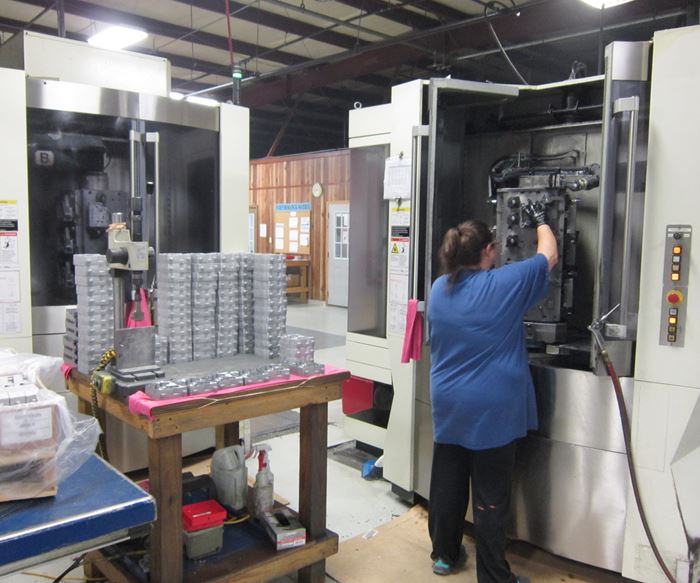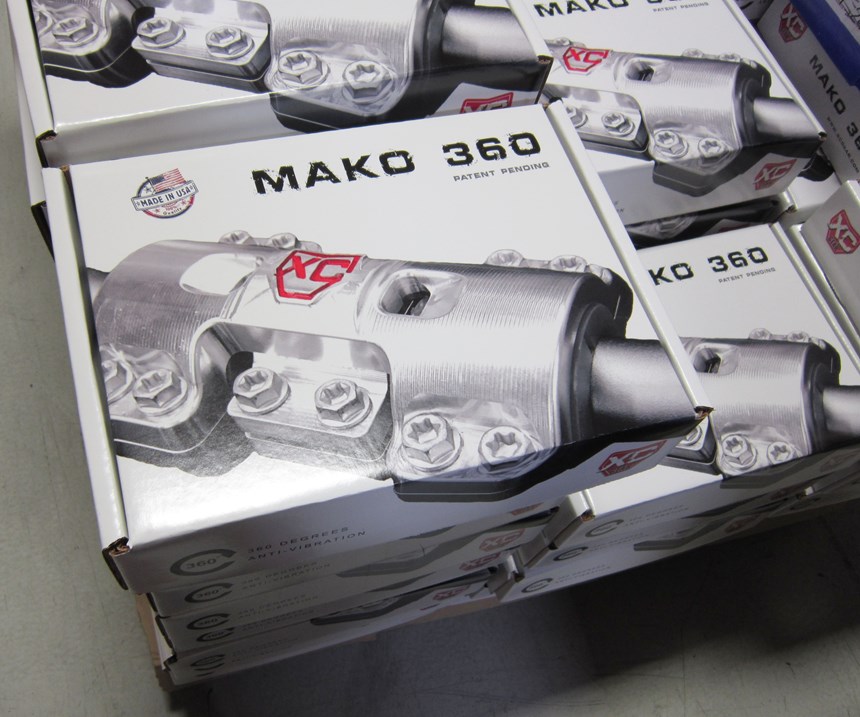Share


Hwacheon Machinery America, Inc.
Featured Content
View More



Takumi USA
Featured Content
View More



Autodesk, Inc.
Featured Content
View MoreFor Cayce Washington, two transformative changes paved the way to his shop’s success: The first was making the move to CNC technology, the second was adding HMC equipment.
Mr. Washington is the owner and president of Valley Tool, located in Water Valley, Mississippi. When he purchased the company from his former employer in 1997 and renamed it, the shop had only manual machines and a couple of punch-tape-programmed knee mills. Recognizing the promise of computer numerical control (CNC), he purchased his first CNC turning center in 1998 and first vertical machining center (VMC) in 1999. It immediately became clear to him how much more productive the shop could be using this equipment in terms of faster, simpler programming and reduced cycle times.
After that, Mr. Washington continued to purchase what he describes to be entry-level CNC machines, and the business continued to be profitable each year. However, this success often required him to put in very long hours to get jobs delivered on time.
Today, the shop has 25 CNC machines, five of which are horizontal machining centers (HMCs). The HMCs are the costliest pieces of equipment in the shop’s 35,000-square-foot facility. Understandably, Mr. Washington and his team mulled over numerous questions before pulling the trigger on that first HMC in 2010. During a recent visit to his shop, we ran through some of those initial questions, and I also learned about how the company is now leveraging this machining platform to its advantage.
Serendipity at a Gas Station
A chance meeting in 2010 with someone at a gas station ultimately led Mr. Washington to seriously consider HMCs. On the way back from Texas, where he personally delivered a job to meet his promised delivery date, Mr. Washington stopped in Louisiana to fuel his vehicle. A person noticed the Valley Tool logo on his shirt and struck up a conversation. That person worked for a large manufacturer of compressors, blowers, vacuum pumps and related industrial equipment, and said the company was having problems with its existing machined-parts vendors. By the time Mr. Washington arrived at his shop, the man had emailed him part prints to review.
The work included upward of 70 part numbers, but volumes for each ranged from only 500 to 1,000. In addition, numerous parts had tight-feature, true-position tolerances. To do this work on the shop’s existing VMCs meant some parts would require multiple setups, and as a result, it would be challenging to achieve those feature-to-feature tolerances. Plus, overall production time would be long because of the numerous setups. Mr. Washington thought that an HMC with dual pallets and fourth-axis motion would mitigate those issues.
A trusted Single Source Technologies-South machine tool salesperson with whom Valley Tool had worked with in the past suggested that HMC technology from Makino might be well-suited for this work. The shop ultimately purchased an a51nx model with 400-mm pallets and a 14,000-rpm spindle featuring 177 foot-pounds of torque that ultimately paid for itself in two years. However, prior to making that purchase, Mr. Washington and his team first thought hard about justifying its cost. Here are a few questions they pondered—questions that are likely similar those that other shops considering adding HMCs might have:
1. Will an HMC assist and/or improve my shop’s existing work?
Mr. Washington said the advantages of an HMC became readily evident by running existing jobs that were previously done on VMCs. The machine’s rigidity enabled faster speeds and feeds, which also helped reduce cycle times. Cycle-time reductions of 30 percent were common the first time a job ran on the HMC compared to when it ran on a VMC, he says. Yet, improvements in programming, tooling and other areas often led to cycle-time reductions of 65 percent the second time it ran on an HMC.
For example, Valley Tool was awarded an assortment of parts that needed to be delivered in short order. To expedite delivery, the shop ran some of the more basic parts across a VMC while it completed more intricate parts on an HMC. However, on a few occasions, it eventually transferred some of those parts to the HMC to improve cycle time and quality (regarding true position from certain datum points) thanks to a reduced number of setups.
After two weeks of VMC programming and fixture design and manufacture for one of those jobs, plus an additional two weeks of fighting to make good parts, the shop threw in the towel and started from scratch, running the job solely on the HMC. In less than 10 days, it was running good parts on the HMC thanks in large part to reducing setups from six to two. In addition, cycle times were reduced from 45 to 18 minutes.
2. How much additional cost will there be to get the most out of an HMC?
HMCs cost more than VMCs, and additional investments are required to use them to their potential. For example, Valley Tool poured 24-inch-deep slabs for each HMC independent of the shop floor to minimize the risk of vibration. HMCs also required the shop to beef up its compressed air capacity with a 30-horsepower screw air compressor because its existing standard air compressor with a holding tank could not keep up with the increased air supply needs.
The shop also made investments in tooling technology. In some cases, long tools or long, thin toolholders are required to reach past a tombstone to prevent the spindle from hitting the fixturing device. To minimize the chance of vibration from tools sticking out far from the toolholder, the shop uses balanced shrink-fit and hydraulic toolholders that provide higher clamping force. In some cases, Valley Tool is also considering higher-end tools to take advantage of the machine’s higher rigidity to further increase speeds and feeds. Because the HMCs have 60-station automatic tool changers (ATCs), it can load multiple tools for multiple upcoming jobs. The shop also loads redundant tools for long-running jobs. On-machine laser probes are used to automatically calculate tool offsets while touch-trigger probes are sometimes used to validate machining processes.
Valley Tool also uses hydraulically actuated tombstone clamping devices on two of its HMCs. These particular machines are dedicated to specific jobs, and the hydraulic clamping simplifies part loading for operators and minimizes the chance for work-related injuries. This workholding technology also provides more consistent clamping pressures and part-holding repeatability.
3. How will an HMC purchase affect my employees?
Mr. Washington says that there was a three- to six-month learning curve for the programmers and operators who had no prior experience with HMCs. This involved on-site training as well as training for some employees at Makino’s Mason, Ohio, headquarters. Some of that learning curve was rethinking how existing VMC work might be fixtured differently on an HMC and how to take advantage of the HMC’s fourth-axis rotation to reduce setups and perform contouring operations.
Also, while an operator can typically see how a tool is engaging with the workpiece on a VMC, an HMC’s tombstone or other fixturing device can sometimes obscure the cutting operation. This can make some operators uneasy at first, but they ultimately come to trust the process. Plus, offline simulation for new programs are performed before those jobs run to help prevent collisions.
One thing Mr. Washington might have done differently is not rushing to get that first HMC producing parts before employees had time to get acquainted with that new machining platform. Early on, a few spindle crashes occurred, which led to vibrations and a couple premature spindle replacements.
That said, the HMC purchases ultimately have served to boost employee morale. This type of investment sends a clear message to employees about how committed the company is to long-term growth while providing them with quality equipment to enable them to do their jobs more effectively and efficiently. It can be terribly frustrating for a machinist to set up a job on a subpar machine just to remove the first completed part for that run and find out it was not machined to specification.
This generally doesn’t happen on the HMCs, Mr. Washington notes. In fact, overall shop scrap rate is now less than 0.5 percent. Plus, spindle utilization of as much as 85 percent can be achieved (compared to 40 percent for VMCs) because an operator can set up a job on the pallet outside the machine while another job is currently running on the other pallet.
4. Will an HMC help me grow my business?
When Valley Tool purchased its first HMC in 2010, the shop employed 85 people and annual sales were approximately $4 million. It now has five HMCs (four a51nx machines and one Hitachi Seiki it purchased used) and 123 employees, and sales in 2017 were $7.5 million.
Some of this can be attributed directly to the addition of HMCs. The shop does not use an outside sales person. However, once word spread through its existing customer base about how its HMCs can produce quality parts faster than VMCs (partly due to reduced setups), the shop began winning additional work.
There also have been instances in which customers’ engineers who have transitioned to new employers have reached out to Valley Tool knowing its capabilities, which also has led to new business. In fact, the shop’s customer base has grown to include companies in a range of industries, including automotive, aerospace, commercial refrigeration, firearms, furniture, industrial commercial equipment, consumer products, medical, moldmaking and sporting goods. This diverse customer base offers balance if there is a decline in business from a particular industry.
Related Content
CNC Machine Shop Honored for Automation, Machine Monitoring
From cobots to machine monitoring, this Top Shop honoree shows that machining technology is about more than the machine tool.
Read MoreOrthopedic Event Discusses Manufacturing Strategies
At the seminar, representatives from multiple companies discussed strategies for making orthopedic devices accurately and efficiently.
Read More4 Commonly Misapplied CNC Features
Misapplication of these important CNC features will result in wasted time, wasted or duplicated effort and/or wasted material.
Read MoreHow to Mitigate Chatter to Boost Machining Rates
There are usually better solutions to chatter than just reducing the feed rate. Through vibration analysis, the chatter problem can be solved, enabling much higher metal removal rates, better quality and longer tool life.
Read MoreRead Next
Building Out a Foundation for Student Machinists
Autodesk and Haas have teamed up to produce an introductory course for students that covers the basics of CAD, CAM and CNC while providing them with a portfolio part.
Read More5 Rules of Thumb for Buying CNC Machine Tools
Use these tips to carefully plan your machine tool purchases and to avoid regretting your decision later.
Read MoreSetting Up the Building Blocks for a Digital Factory
Woodward Inc. spent over a year developing an API to connect machines to its digital factory. Caron Engineering’s MiConnect has cut most of this process while also granting the shop greater access to machine information.
Read More


















































